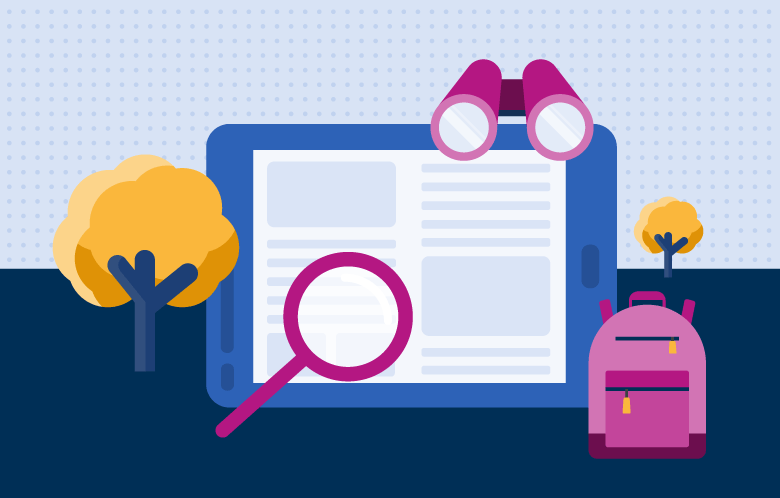Teaching research is always challenging, and students have many individual questions once they start working. At Westerville South High School in Westerville, Ohio, teaching research skills is a team effort. Jen is a high school English teacher who doubles as a volunteer adjunct for our school’s College Credit Plus (CCP) composition courses, and Brandi is our school librarian. This year’s pandemic gave us a chance to revamp our approach to research skills instruction, and our students did some of the best work we’ve seen yet.
Background
CCP is Ohio’s post-secondary education program. Any Ohio student in grades 7-12 can enroll in a college course if they meet the college’s entrance requirements. A student in a CCP course receives high school and college credit simultaneously, provided they pass the course. Some courses, such as Composition I and Composition II, are offered at the district level through a facilitator or volunteer adjunct from the college. Others are offered only at the college campus or online. Some high school students will take only one or two CCP courses, while others will do their entire course load through a college campus.
Our students are primarily juniors and seniors who decide to take CCP composition courses through Columbus State Community College (CSCC) rather than the traditional junior and senior English courses offered at our high school. The curricula do not entirely align; the composition courses assume students have had ample opportunities to refine their writing skills through four years of high school English. As a result, we see some gaps in student skill sets that we wouldn’t see if they were typical college freshmen. One of the most significant gaps for our students has consistently been in research skills. The issue isn’t that they haven’t been taught how to research; the issue is that they haven’t had time to practice research enough to make it an automatic skill.
Research Boot Camp
The Composition I course establishes foundational skills for college writing and covers database use, but Composition II (a college sophomore writing course) requires a deep dive into a semester-long research assignment. Students identify a topic of interest and produce four writing projects totaling at least 5,000 words. The projects include a response to a text, an annotated bibliography, an argumentative research paper, and a rhetorical analysis of their research paper, so each assignment builds on the one before. We use a workshop model for this course so that students can complete the intensive research in class with frequent conferences along the way. We soon realized students needed more time to practice college research skills to develop the muscle memory necessary to research effectively. However, if we gave them the time to practice during the course, they would lose time to do quality research and their final drafts would suffer. Fortunately, our district’s semester starts about two weeks before CSCC’s semester begins, so we used that time to run our students through Research Boot Camp.
Over eight days, we ran our Research Boot Camp remotely, recording each lesson in Google Meet so students who were unable to attend could watch at their convenience. Future boot camps will be more interactive and engaging because students will be able to work together. Had we been in person, more of the activities would have been in game format. However, we did do a review game via Kahoot! at the end of each section. Download our Google Slide deck to see the major topics we covered.
Using Databases
While students may have used databases in their high school freshman and sophomore English courses, they typically needed to find only one or two sources. Often, however, students were more comfortable typing a question into Google to find their sources. For this reason, we always begin boot camp with navigating the EBSCO database suite.
We start students with the general databases, such as Explora™ and Academic Search™ Complete, and then show them how to access subject-specific databases. Once they know what’s out there, we highlight how they can save articles to Google Drive, use the citation tool to help them build their works cited list, and turn on Text-to-Speech to hear the article read aloud.
Often, their research will take them to academic sources, which tend to be longer and at a higher reading level than they are used to. To help them, we also practice deciding if the resource is appropriate for their needs by teaching academic skimming, which is when students focus only on the main ideas of a text to quickly discover if the source is relevant to their topic.
Citing & Annotating Sources
Once they determine if their source is appropriate, we work on in-text citations. This is a significant weakness in our students, many of whom are still simply using a hyperlink to cite even though they have learned how to cite using MLA and/or APA formatting. This was the biggest surprise for us. We remember having to do citations by hand (and we aren’t that old!) and triple-checking each citation to make sure the punctuation was correct.
Today, students can simply copy and paste citations from the database. We had reviewed this in Composition I, but they were still not doing it correctly. Even students who did know were not taking the time to format their citations in alphabetical order or using hanging indents. Therefore, we spend a lot of time on in-text citations for partial quotes, paraphrases and full quotes; signal phrases; and citations matching the works cited page. Then we focus on the Works Cited page itself, specifically how to use alphabetical order and hanging indents and write citations for sources with missing information.
In our time teaching Composition II, we have also found that students who read their sources carefully and take detailed notes write much better papers, so we teach annotation next. We encourage students to just do it — annotate their hearts out! Students learn that annotation is more than highlighting interesting text; annotations are brain dumps onto their papers. If they think a thought while they read, they need to write it down somewhere — on a paper copy or in their digital copy.
Organizing Research
We’ve also found that the most organized students write the best papers, so we end boot camp with strategies for organizing their research. We used a two-column graphic organizer this year, and students who completed the graphic organizer wrote better papers than those who did not fill it out. We encouraged students to read or skim an article and then plug the information from the article into the graphic organizer. The graphic organizer asks for notes from the resource, questions about the source, keywords used in their search, reliability of the source, a short summary of the resource, quotes (cited) they plan to use, and a reflection on how useful the source might be for their paper. We worked on note taking and putting their information into the graphic organizer in a way that makes sense.
One student came up with something she calls a “quote farm,” which divides quotes for their paper into topic areas. The student said between the two-column graphic organizer and her quote farm, she developed a paper she was proud of (that also received a high score). Check out EBSCO’s Research and Writing Tips for Students which includes a research graphic organizer and other helpful handouts.
Wrap Up
Research skills can be hard to teach and even harder to grade since student understanding can't be measured using multiple choice questions. Educators must invest a lot of time to engage students meaningfully in the research process and assess their understanding along the way. Partnering with your school librarian to "pre-load" research skills as we've described above will help you maximize your time and lead students to produce higher-quality research projects.



